Coburn J.W. Algebra and Trigonometry
Подождите немного. Документ загружается.

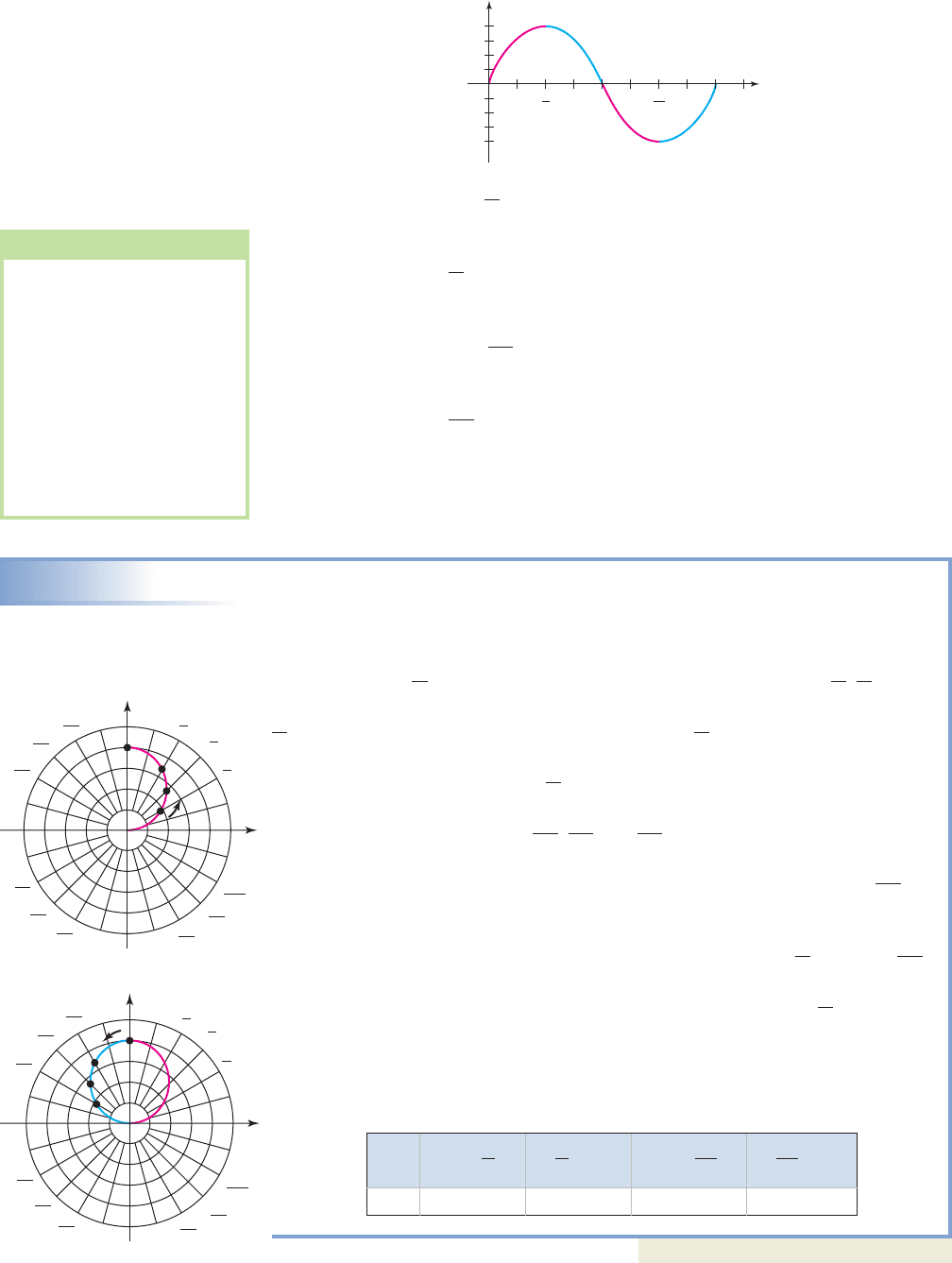
1. As moves from 0 to is positive and increases from 0 to 1.
for
2. As moves from to is positive and decreases from 1 to 0.
for r is decreasing
3. As moves from to is negative and increases from 0 to 1.
for r is increasing
4. As moves from to is negative and decreases from 1 to 0.
for r is decreasing
In summary, note that the value of goes through four cycles, two where it is
increasing from 0 to 1 (in red), and two where it is decreasing from 1 to 0 (in blue).
EXAMPLE 5
Graphing Polar Equations Using an r-Value Analysis
Sketch the graph of using an r-value analysis.
Solution
Begin by noting that at and will increase from 0 to 4 as the clock
“ticks” from 0 to since is increasing from 0 to 1. (1) For and
and respectively (at ). See Figure 10.41.
(2) As continues “ticking” from to decreases from 4 to 0, since is
decreasing from 1 to 0. For and
and respectively (at ). See Figure 10.42. (3) From to
increases from 0 to 4, but since , this portion of the graph is reflected back
into Quadrant I, overlapping the portion already drawn from 0 to (4) From
to decreases from 4 to 0, overlapping the portion drawn from to We
conclude the graph is a closed figure limited to Quadrants I and II as shown in
Figure 10.42. This is a circle with radius 2, centered at (0, 2). In summary:
.
2
2,
r
3
2
2
.
r 6 0
3
2
,
r
, r 0r 2,
5
6
, r 3.5, r 2.8,
2
3
,
3
4
,
sin ,
r
2
2
, r 4r 3.5,
3
, r 2, r 2.8,
6
,
4
,sin
2
,
0,r 0
r 4 sin
r
r sin ,1
sin
2, sin
3
2
r sin ,1
sin
3
2
, sin
r sin ,1
sin
, sin
2
r sin , r is increasing
1
sin
2
, sin
970 CHAPTER 10 Analytic Geometry and the Conic Sections 10-52
Figure 10.40
Figure 10.41
Figure 10.42
r sin
1
1
(1)
(2)
(3) (4)
2
r
2
3
2
WORTHY OF NOTE
It is important to remember
that if the related
point on the graph is
units from center,
in the opposite direction:
In
addition, students are
encouraged not to use a
table of values, a conversion
to rectangular coordinates, or
a graphing calculator until
after the r-value analysis.
1r, 2S 1r, 180°2.
180°
r
r 6 0,
4
(1)
2
3
5
3
4
6
7
4
5
3
4
3
5
4
7
6
5
6
3
4
2
3
11
6
1
2
3
5
3
4
6
7
4
5
3
4
3
5
4
7
6
5
6
3
4
2
3
11
6
4
1
(1) and (3)
(2) and (4)
Now try Exercises 57 and 58
0 to to to to
0 to 4 4 to 0 0 to 4 4 to 0
r
2
3
2
3
2
2
2
r 4 sin
College Algebra & Trignometry—
cob19529_ch10_0966-0978.qxd 12/6/08 12:49 AM Page 970 epg HD 049 :Desktop Folder:Satya 05/12/08:
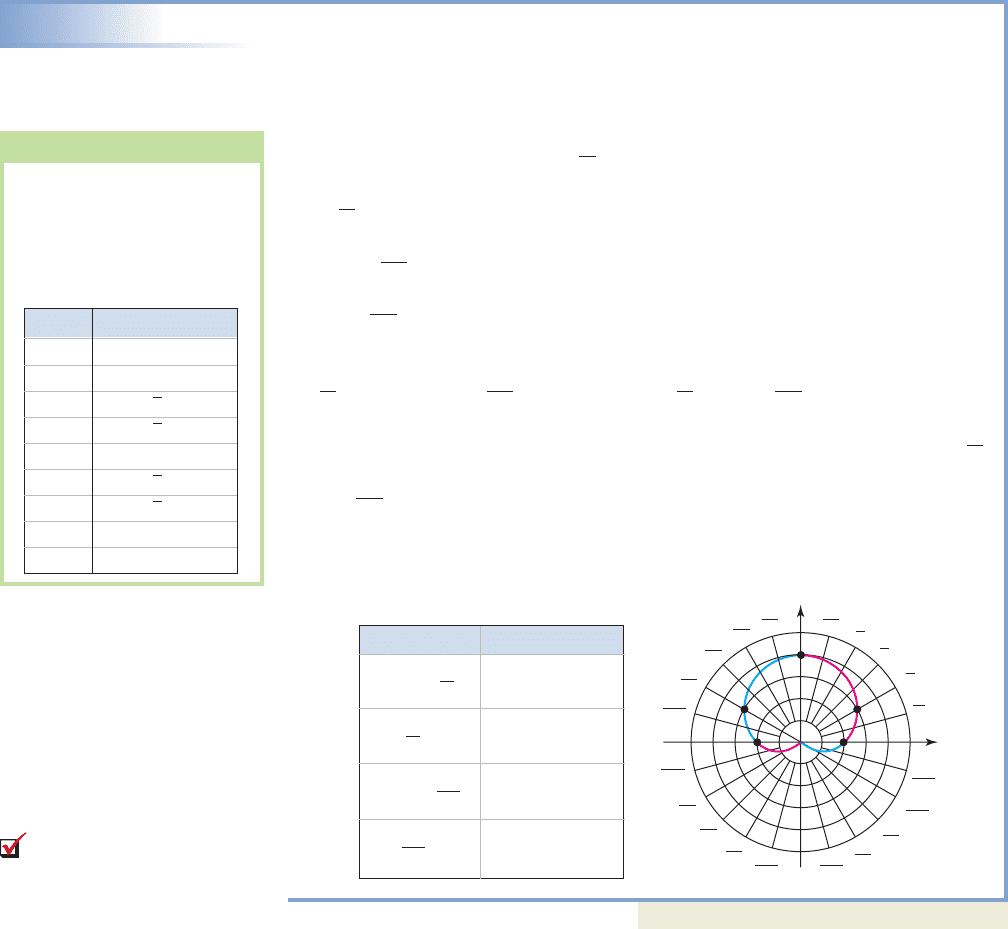
10-53 Section 10.5 Polar Coordinates, Equations, and Graphs 971
College Algebra & Trignometry—
Although it takes some effort, r-value analysis offers an efficient way to graph
polar equations, and gives a better understanding of graphing in polar coordinates. In
addition, it often enables you to sketch the graph with a minimum number of calcula-
tions and plotted points. As you continue using the technique, it will help to have
Figure 10.40 in plain view for quick reference, as well as the corresponding analysis
of for polar graphs involving cosine (see Exercise 98).
EXAMPLE 6
Graphing Polar Equations Using an r-Value Analysis
Sketch the graph of using an r-value analysis.
Solution
Since the minimum value of is , we note that r will always be greater than
or equal to zero. At , r has a value of 2 ( ), and will increase from 2
to 4 as the clock “ticks” from 0 to ( is positive and is increasing).
From to , r decreases from 4 to 2 ( is positive and is decreasing).
From to , r decreases from 2 to 0 ( is negative and is increasing);
and from to , r increases from 0 to 2 ( is negative and is
decreasing). We conclude the graph is a closed figure containing the points (2, 0),
, and . Noting that and will produce
integer values, we evaluate and obtain the additional points
and . Using these points and the r-value analysis produces the
graph shown here, called a cardioid (from the limaçon family of curves). In
summary we have:
a3,
5
6
b
a3,
6
br 2 2 sin
5
6
6
a0,
3
2
ba4,
2
b, 12, 2
sin
sin 2
3
2
sin
sin
3
2
sin
sin
2
sin
sin
2
sin 0 0 0
1sin
r 2 2 sin
y cos
WORTHY OF NOTE
While the same graph is
obtained by simply plotting
points, using an r-value
analysis is often more
efficient, particularly with
more complex equations.
1
2
3
4
5
3
4
6
12
7
4
5
3
4
3
5
4
7
6
5
6
3
4
2
3
23
12
5
12
7
12
19
12
17
12
13
12
11
12
11
6
(2)
(1)
(4)(3)
Now try Exercises 59 through 62
E. Symmetry and Families of Polar Graphs
Even with a careful r-value analysis, some polar graphs require a good deal of effort
to produce. In many cases, symmetry can be a big help, as can recognizing certain
families of equations and their related graphs. As with other forms of graphing,
gathering this information beforehand will enable you to graph relations with a
smaller number of plotted points. Figures 10.43 to 10.46 offer some examples of
symmetry for polar graphs.
D. You’ve just learned how
to sketch basic polar graphs
using an r-value analysis
(1) 0 to 2 to 4
(2) to 4 to 2
(3) to 2 to 0
(4) to 0 to 22
3
2
3
2
2
2
r 2 2 sin
00
30 2
45
60
90 4
120
135
150 2
180 0
212
2.8
213 3.5
213 3.5
212 2.8
r 4 sin
cob19529_ch10_0966-0978.qxd 12/6/08 12:49 AM Page 971 epg HD 049 :Desktop Folder:Satya 05/12/08:
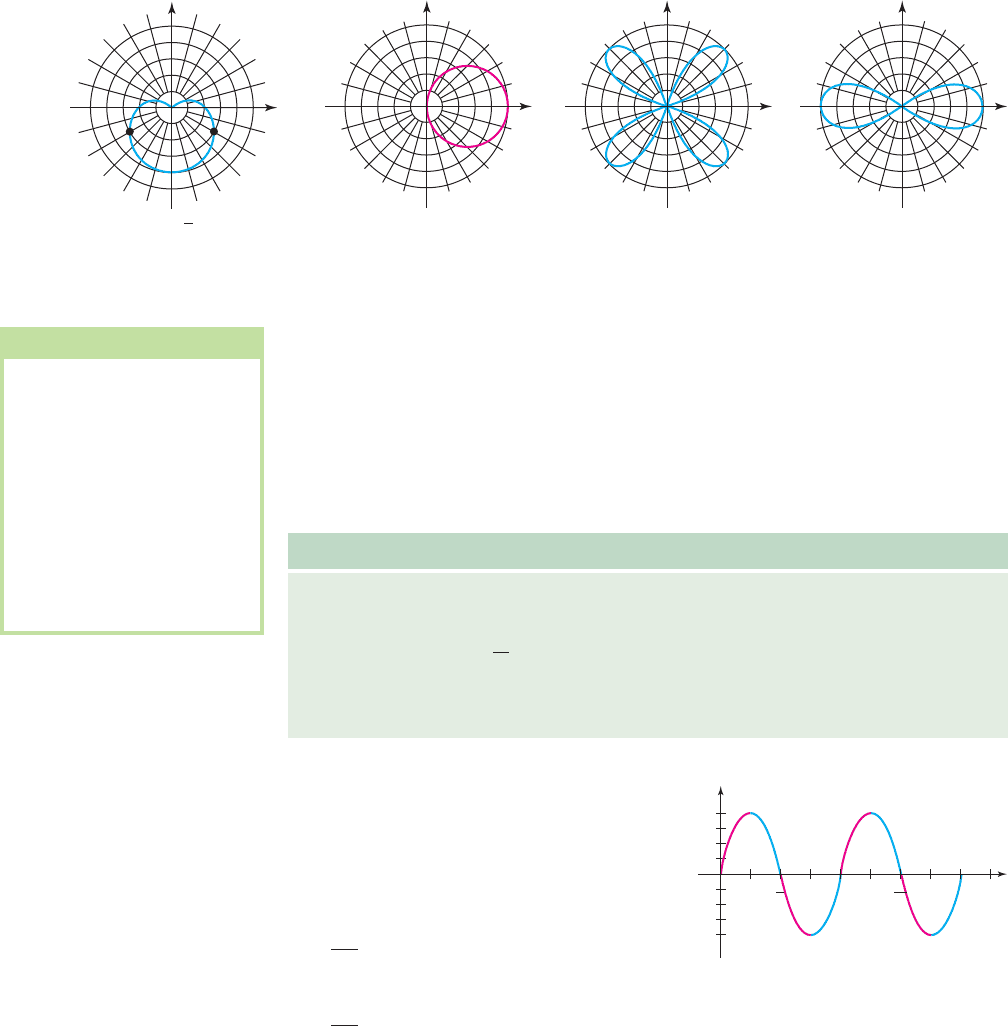
972 CHAPTER 10 Analytic Geometry and the Conic Sections 10-54
WORTHY OF NOTE
In mathematics we refer to
the tests for polar symmetry
as sufficient but not
necessary conditions. The
tests are sufficient to show
symmetry (if the test is
satisfied, the graph must be
symmetric), but the tests are
not necessary to show
symmetry (the graph may be
symmetric even if the test is
not satisfied).
1
2
3
4
5
2
2
3
4
5
1
2
3
4
5
1
2
3
4
5
1
Figure 10.43 Figure 10.44 Figure 10.45 Figure 10.46
The tests for symmetry in polar coordinates bear a strong resemblance to those for
rectangular coordinates, but there is a major difference. Since there are many differ-
ent ways to name a point in polar coordinates, a polar graph may actually exhibit a
form of symmetry without satisfying the related test. In other words, the tests are suf-
ficient to establish symmetry, but not necessary.
The formal tests for symmetry are explored in Exercises 100 to 102. For our pur-
poses, we’ll rely on a somewhat narrower view, one that is actually a synthesis of our
observations here and our previous experience with the sine and cosine.
Symmetry for Graphs of Certain Polar Equations
Given the polar equation ,
1. If represents an expression in terms of sine(s), the graph will be
symmetric to and are on the graph.
2. If represents an expression in terms of cosine(s), the graph will be
symmetric to and ( ) are on the graph.
While the fundamental ideas from Exam-
ples 5 and 6 go a long way toward graphing
other polar equations, our discussion would
not be complete without a review of the
period of sine and cosine. Many polar equa-
tions have factors of or in
them, and it helps to recall the period formula
. Comparing from
Example 5 with we note the period of sine changes from to
, meaning there will be twice as many cycles and will now go through
eight cycles—four where is increasing from 0 to 1 (in red), and four where it
is decreasing from 1 to 0 (in blue). See Figure 10.47.
sin122
r
P
2
2
P 2r 4 sin122,
r 4 sin P
2
n
cos1n2sin1n2
r, 0: 1r, 2
f 12
1r, 2
2
: 1r, 2
f 12
r f 12
y sin(2)
1
1
(1)
(2) (5) (6)
(3) (4) (7) (8)
2
y
2
3
2
Figure 10.47
Vertical-axis symmetry: Polar-axis symmetry: Polar symmetry: Polar symmetry:
r
2
25 sin122r 5 sin 122
r 5 sinr 2 2 sin
College Algebra & Trignometry—
cob19529_ch10_0966-0978.qxd 12/6/08 12:49 AM Page 972 epg HD 049 :Desktop Folder:Satya 05/12/08:

10-55 Section 10.5 Polar Coordinates, Equations, and Graphs 973
College Algebra & Trignometry—
EXAMPLE 7
Sketching Polar Graphs Using Symmetry and r-Values
Sketch the graph of using symmetry and an r-value analysis.
Solution
Since r is expressed in terms of sine, the graph will be symmetric to . We
note that at , where n is even, and the graph will go through the pole
at these points. This also tells us the graph will be a closed figure. From the graph
of in Figure 10.47, we see at , and , so the
graph will include the points , and . Only the
analysis of the first four cycles is given next, since the remainder of the graph can
be drawn using symmetry.
a4,
7
4
ba4,
4
b, a4,
3
4
b, a4,
5
4
b
7
4
4
,
3
4
,
5
4
sin122
1sin122
n
2
r 0
2
r 4 sin122
1
2
3
4
5
3
4
6
12
7
4
5
3
4
3
5
4
7
6
5
6
3
4
2
3
23
12
5
12
7
12
19
12
17
12
13
12
11
12
11
6
(2)
(4)
(1)
(3)
|r|
0 to 0 to 4
to 4 to 0
to 0 to 4
to 4 to 0
3
4
3
4
2
2
4
4
Plotting the points and applying the r-value analysis with the symmetry involved
produces the graph in the figure, called a four-leaf rose. At any time during this
process, additional points can be calculated to “round-out” the graph.
Now try Exercises 63 through 70
Graphing Polar Equations
To assist the process of graphing polar equations:
1. Carefully note any symmetries you can use.
2. Have graphs of and in view for quick reference.
3. Use these graphs to analyze the value of r as the “clock ticks” around the
polar grid: (a) determine the max/min r-values and write them in polar form,
and (b) determine the polar-axis intercepts and write them in polar form.
4. Plot the points, then use the r-value analysis and any symmetries to complete
the graph.
y cos1n2y sin1n2
r 4 sin122
Cycle r-Value Analysis Location of Graph
(1) 0 to increases from 0 to 4 QI
(2) to decreases from 4 to 0 QI
(3) to increases from 0 to 4 QIV
(4) to decreases from 4 to 0 QIV 1r 6 02
r
3
4
1r 6 02
r
3
4
2
1r 7 02
r
2
4
1r 7 02
r
4
cob19529_ch10_0966-0978.qxd 12/6/08 12:49 AM Page 973 epg HD 049 :Desktop Folder:Satya 05/12/08:
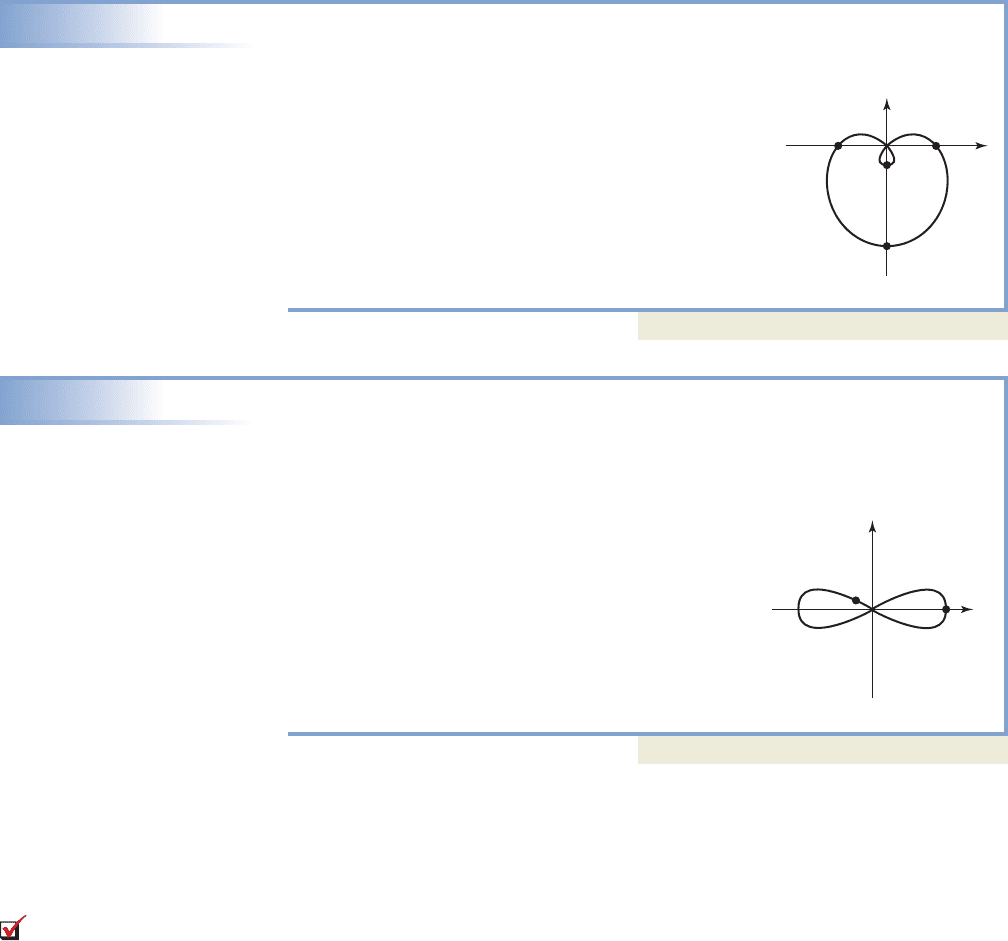
Similar to polynomial graphs, polar graphs come in numerous shapes and vari-
eties, yet many of them share common characteristics and can be organized into certain
families. Some of the more common families are illustrated in Appendix V, and give
the general equation and related graph for common family members. Also included are
characteristics of certain graphs that will enable you to develop the polar equation
given its graph or information about its graph. For further investigations using a graph-
ing calculator, see Exercises 71 through 76.
EXAMPLE 8
Graphing a Limaçon Using Stated Conditions
Find the equation of the polar curve satisfying the given conditions, then sketch the
graph: limaçon, symmetric to , with and .
Solution
The general equation of a limaçon symmetric to
is , so our desired equation is
. Since , the limaçon has an
inner loop of length and a maximum
distance from the origin of . The polar-axis
intercepts are (2, 0) and . With the graph
is reflected across the polar axis (facing “downward”).
The complete graph is shown in the figure.
Now try Exercises 79 through 94
EXAMPLE 9
Modeling the Flight Path of a Scavenger Bird
Scavenger birds sometimes fly over dead or dying animals (called carrion) in a
“figure-eight” formation, closely resembling the graph of a lemniscate. Suppose
the flight path of one of these birds was plotted and found to contain the polar
coordinates (81, ) and (0, ). Find the equation of
the lemniscate. If the bird lands at the point (r, ),
how far is it from the carrion? Assume r is in yards.
Solution
Since (81, ) is a point on the graph, the lemniscate is
symmetric to the polar axis and the general equation is
. The point (81, ) indicates ,
hence the equation is . At
we have , and the bird has landed
away.
Now try Exercises 95 through 97
You’ve likely been wondering how the different families of polar graphs were
named. The roses are easy to figure as each graph has a flower-like appearance. The
limaçon (pronounced li-ma-sawn) family takes its name from the Latin words limax
or lamacis, meaning “snail.” With some imagination, these graphs do have the appear-
ance of a snail shell. The cardioids are a subset of the limaçon family and are so named
due to their obvious resemblance to the human heart. In fact, the name stems from the
Greek kardiameaning heart, and many derivative words are still in common use (a car-
diologist is one who specializes in a study of the heart). Finally, there is the lemnis-
cate family, a name derived from the Latin lemniscus, which describes a certain kind
of ribbon. Once again, a little creativity enables us to make the connection between
ribbons, bows, and the shape of this graph.
r 15 yd
r
2
6561 cos 272°
136°r
2
6561 cos122
a 810°r
2
a
2
cos122
0°
136°
45°0°
b 6 0,12, 180°2
2 3 5
3 2 1
a
6
b
r 2 3 sin
r a b sin 90°
b 3a 2 90°
974 CHAPTER 10 Analytic Geometry and the Conic Sections 10-56
(
1, 90)
(5, 270)
(2, 0)(2, 180)
Lemniscate
(81, 0)
(15, 136)
E. You’ve just learned how
to use symmetry and families
of curves to write a polar
equation given a polar graph
or information about the
graph
College Algebra & Trignometry—
cob19529_ch10_0966-0978.qxd 12/6/08 12:49 AM Page 974 epg HD 049 :Desktop Folder:Satya 05/12/08:
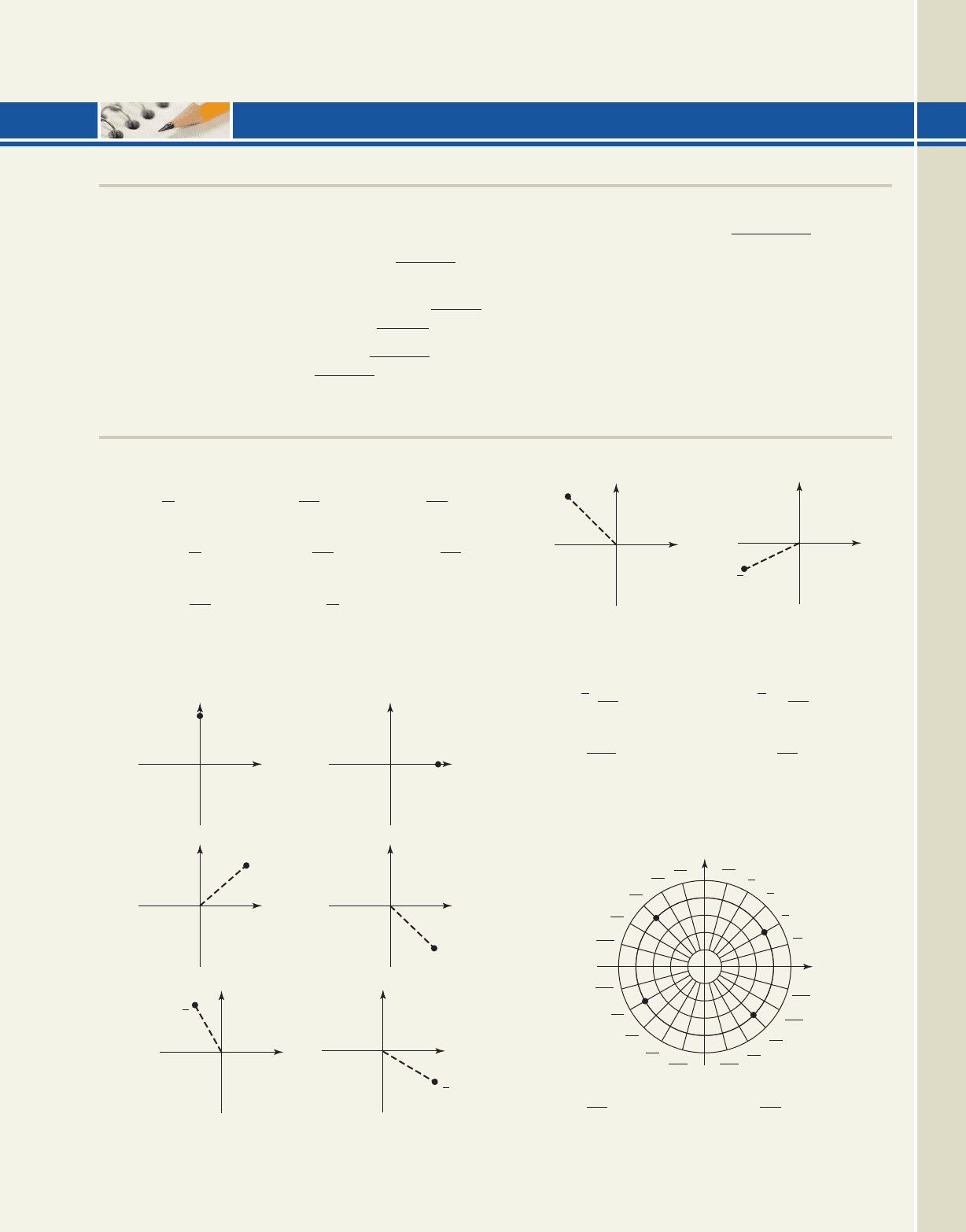
10-57 Section 10.5 Polar Coordinates, Equations, and Graphs 975
10.5 EXERCISES
4. If a polar equation is given in terms of cosine, the
graph will be symmetric to .
5. Write out the procedure for plotting points in polar
coordinates, as though you were explaining the
process to a friend.
6. Discuss the graph of in terms of an
r-value analysis, using and a color-coded
graph.
y cos
r 6 cos
Fill in each blank with the appropriate word or phrase.
Carefully reread the section if needed.
1. The point (r, ) is said to be written in
coordinates.
2. In polar coordinates, the origin is called the
and the horizontal axis is called the axis.
3. The point (4, ) is located in Q , while
( ) is located in Q .
4, 135°
135°
CONCEPTS AND VOCABULARY
DEVELOPING YOUR SKILLS
Plot the following points using polar graph paper.
7. 8. 9.
10. 11. 12.
13. 14.
Express the points shown using polar coordinates with
in radians, and .
15. 16.
17. 18.
19. 20.
(4, 4√3)
y
x
(4, 4)
y
x
(4, 4)
y
x
(4, 0)
y
x
(0, 4)
y
x
r 0
0 2
a4,
4
ba3,
2
3
b
a4,
7
4
ba5,
5
6
ba4.5,
3
b
a2,
5
4
ba3,
3
2
ba4,
2
b
21. 22.
List three alternative ways the given points can be
expressed in polar coordinates using , and
[).
23. 24.
25. 26.
Match each (r, ) given to one of the points A, B, C,
or D shown.
a3,
7
6
ba2,
11
6
b
a413
,
5
3
ba312,
3
4
b
2, 2
r 0, r 0
(4√3, 4)
y
x
(4, 4)
y
x
(4√3, 4)
y
x
A
B
C
D
2
3
4
5
3
4
6
7
4
5
3
4
3
5
4
7
6
5
6
3
4
2
3
23
12
5
12
7
12
19
12
17
12
13
12
11
12
11
6
12
1
Exercise 27–36
27. 28. a4,
5
4
ba4,
5
6
b
College Algebra & Trignometry—
cob19529_ch10_0966-0978.qxd 12/6/08 12:49 AM Page 975 epg HD 049 :Desktop Folder:Satya 05/12/08:

976 CHAPTER 10 Analytic Geometry and the Conic Sections 10-58
College Algebra & Trignometry—
29. 30.
31. 32.
33. 34.
35. 36.
Convert from rectangular coordinates to polar
coordinates. A diagram may help.
37. (, 0) 38. (0, )
39. (4, 4) 40.
41. () 42. (6, )
43. () 44. ( , 12)
Convert from polar coordinates to rectangular
coordinates. A diagram may help.
45. (8, ) 46. (6, )
47. 48.
49. 50.
51. 52. 14, 30°215, 135°2
a10,
4
3
ba2,
7
6
b
a5,
5
6
ba4,
3
4
b
60°45°
3.55, 12
613
512, 512
1413, 42
78
a4,
35
6
ba4,
21
4
b
a4,
19
6
ba4,
13
6
b
a4,
4
ba4,
5
4
b
a4,
3
4
ba4,
6
b
Sketch each polar graph using an r-value analysis
(a table may help), symmetry, and any convenient
points.
53. 54.
55. 56.
57. 58.
59. 60.
61. 62.
63. 64.
65. 66.
67. 68.
69. 70.
Use a graphing calculator in polar mode to produce the
following polar graphs.
71. , a hippopede
72. a conchoid
73. a cissoid
74. , a kappa curve
75. , a bifoliate
76. , a foliumr 8 cos 14 sin
2
22
r 8 sin cos
2
r cot
r 2 cos cot ,
r 3 csc ,
r 421 sin
2
r 6 cosa
2
br 4 sina
2
b
r
2
16 cos122r
2
9 sin122
r 6 cos152r 4 sin 2
r 3 sin142r 5 cos122
r 1 2 cos r 2 4 sin
r 2 2 cos r 3 3 sin
r 2 sin r 4 cos
3
4
6
r 6r 5
WORKING WITH FORMULAS
77. The midpoint formula in polar coordinates:
The midpoint of a line segment connecting the
points (r, ) and (R, ) in polar coordinates can be
found using the formula shown. Find the midpoint
of the line segment between and
, then convert these points to
rectangular coordinates and find the midpoint using
the “standard” formula. Do the results match?
1R, 2 18, 30°2
1r, 2 16, 45°2
M a
r cos R cos
2
,
r sin R sin
2
b
78. The distance formula in polar coordinates:
Using the law of cosines, it can be shown that the
distance between the points (R, ) and (r, ) in
polar coordinates is given by the formula indicated.
Use the formula to find the distance between
and , then
convert these to rectangular coordinates and
compute the distance between them using the
“standard” formula. Do the results match?
1r, 2 18, 30°21R, 2 16, 45°2
d 2R
2
r
2
2Rr cos
(
)
APPLICATIONS
Polar graphs: Find the equation of a polar graph satisfying
the given conditions, then sketch the graph.
79. limaçon, symmetric to polar axis, and b 4a 4
80. rose, four petals, two petals symmetric to the polar
axis,
81. rose, five petals, one petal symmetric to the polar
axis, a 4
a 6
cob19529_ch10_0966-0978.qxd 12/6/08 12:49 AM Page 976 epg HD 049 :Desktop Folder:Satya 05/12/08:

10-59 Section 10.5 Polar Coordinates, Equations, and Graphs 977
College Algebra & Trignometry—
EXTENDING THE CONCEPT
99. The polar graph is called the Spiral of
Archimedes. Consider the spiral . As this
graph spirals around the origin, what is the distance
between each positive, polar intercept? In QI, what
is the distance between consecutive branches of the
r
1
2
r a
spiral each time it intersects What is the
distance between consecutive branches of the spiral
at ? What can you conclude?
2
4
?
82. limaçon, symmetric to and
83. lemniscate, through ( , 4)
84. lemniscate, through
85. circle, symmetric to , center at ,
containing
86. circle, symmetric to polar axis, through
Matching: Match each graph to its equation a through h,
which follow. Justify your answers.
87. 88.
89. 90.
91. 92.
93. 94.
6
6
6
6
6
6
6
6
16, 2
a2,
6
b
a2,
2
b
2
a8,
4
ba 8
a 4
b 4
2
, a 2
a. b.
c. d.
e. f.
g. h.
95. Figure eights: Waiting for help to arrive on foot, a
light plane is circling over some stranded hikers
using a “figure eight” formation, closely
resembling the graph of a lemniscate. Suppose the
flight path of the plane was plotted (using the
hikers as the origin) and found to contain the polar
coordinates (7200, ) and (0, ) with r in
meters. Find the equation of the lemniscate.
96. Animal territories: Territorial animals often prowl
the borders of their territory, marking the
boundaries with various bodily excretions. Suppose
the territory of one such animal was limaçon
shaped, with the pole representing the den of the
animal. Find the polar equation defining the
animal’s territory if markings are left at (750, ),
(1000, ), and (750, ). Assume r is in meters.
97. Prop manufacturing: The propellers for a toy
boat are manufactured by stamping out a rose with
n petals and then bending each blade. If the
manufacturer wants propellers with five blades and
a radius of 15 mm, what two polar equations will
satisfy these specifications?
98. Polar curves and cosine: Do a complete r-value
analysis for graphing polar curves involving
cosine. Include a color-coded graph showing the
relationship between r and , similar to the analysis
for sines that preceded Example 6.
180°90°
0°
90°45°
r 6 sin152r 6 sin
r 2 4 sin r
2
36 sin122
r
2
36 cos122r 6 cos142
r 3 3 sin r 6 cos
cob19529_ch10_0966-0978.qxd 12/6/08 12:49 AM Page 977 epg HD 049 :Desktop Folder:Satya 05/12/08:

978 CHAPTER 10 Analytic Geometry and the Conic Sections 10-60
College Algebra & Trignometry—
MAINTAINING YOUR SKILLS
106. (6.2) Verify the following is an identity:
.
107. (6.7) Solve for
108. (1.3) Solve the absolute value inequality. Answer
in interval notation:
3
2x 5
7 7 19
20 5 30 sina2t
6
b.
t 30, 22:
cos
2
x sin
2
x 1 sin12x2 tan x
109. (2.7) Graph the piecewise function shown and state
its domain and range.
f1x2 •
x 2 5 x 6 1
x 1 x 6 2
4 2 6 x 5
As mentioned in the exposition, tests for symmetry of
polar graphs are sufficient to show symmetry (if the test
is satisfied, the graph must be symmetric), but the tests
are not necessary to show symmetry (the graph may be
symmetric even if the test is not satisfied). For ,
the formal tests for the symmetry are: (1) the graph will
be symmetric to the polar axis if ; (2) the
graph will be symmetric to the line if
; and (3) the graph will be symmetric to
the pole if .
100. Sketch the graph of Show the
equation fails the first test, yet the graph is still
symmetric to the polar axis.
101. Why is the graph of every lemniscate symmetric to
the pole?
102. Verify that the graph of every limaçon of the form
is symmetric to the polar axis.r a b cos
r 4 sin122.
f() f()
f( ) f()
2
f() f()
r f()
103. The graphs of and are
from the rose family of polar graphs. If n is odd,
there are n petals in the rose, and if n is even, there
are 2n petals. An interesting extension of this fact
is that the n petals enclose exactly 25% of the area
of the circumscribed circle, and the 2n petals
enclose exactly 50%. Find the area within the
boundaries of the rose defined by
To develop an understanding of polar equations, we
used the following facts , and
. Using these relationships, we can actually
convert polar equations to rectangular equations and
vice versa, showing that a particular equation can be
graphed in either form. Use these relationships to write
these polar equations in rectangular form. (Hint: Isolate
the term kr (k a constant) on one side, then square.)
104. 105. r
6
2 4 sin
r
1
1 sin
y r sin
x
2
y
2
r
2
, x r cos
r 6 sin152.
r a cos1n2r a sin1n2
10.6 More on the Conic Sections: Rotation of Axes and Polar Form
Our study of conic sections would not be complete without considering conic sections
whose graphs are not symmetric to a vertical or horizontal axis. The axis of symme-
try still exists, but is rotated by some angle. We’ll first study these rotated conics using
the equation in its polynomial form, then investigate some interesting applications
of the polar form.
A. Rotated Conics and the Rotation of Axes
It’s always easier to understand a new idea in terms of a known idea, so we begin our
study with a review of the reciprocal function . From the equation we note:
1. The denominator is zero when and the y-axis is a vertical asymptote (the
vertical line ).
2. Since the degree of the numerator is less than the degree of the denominator, the
x-axis is a horizontal asymptote (the horizontal line ).
3. Since implies and implies the graph will have two
branches—one in the first quadrant and one in the third.
y 7 0,x 7 0y 6 0x 6 0
y 0
x 0
x 0,
y
1
x
Learning Objectives
In Section 10.6 you will learn how to:
A. Graph conic sections
that have nonvertical
and nonhorizontal axes
(rotated conics)
B. Identify conics using the
discriminant of the
polynomial form—the
invariant
C. Write the equation of
a conic section in
polar form
D. Solve applications
involving the conic
sections in polar form
B
2
4AC
cob19529_ch10_0966-0978.qxd 12/6/08 12:49 AM Page 978 epg HD 049 :Desktop Folder:Satya 05/12/08:
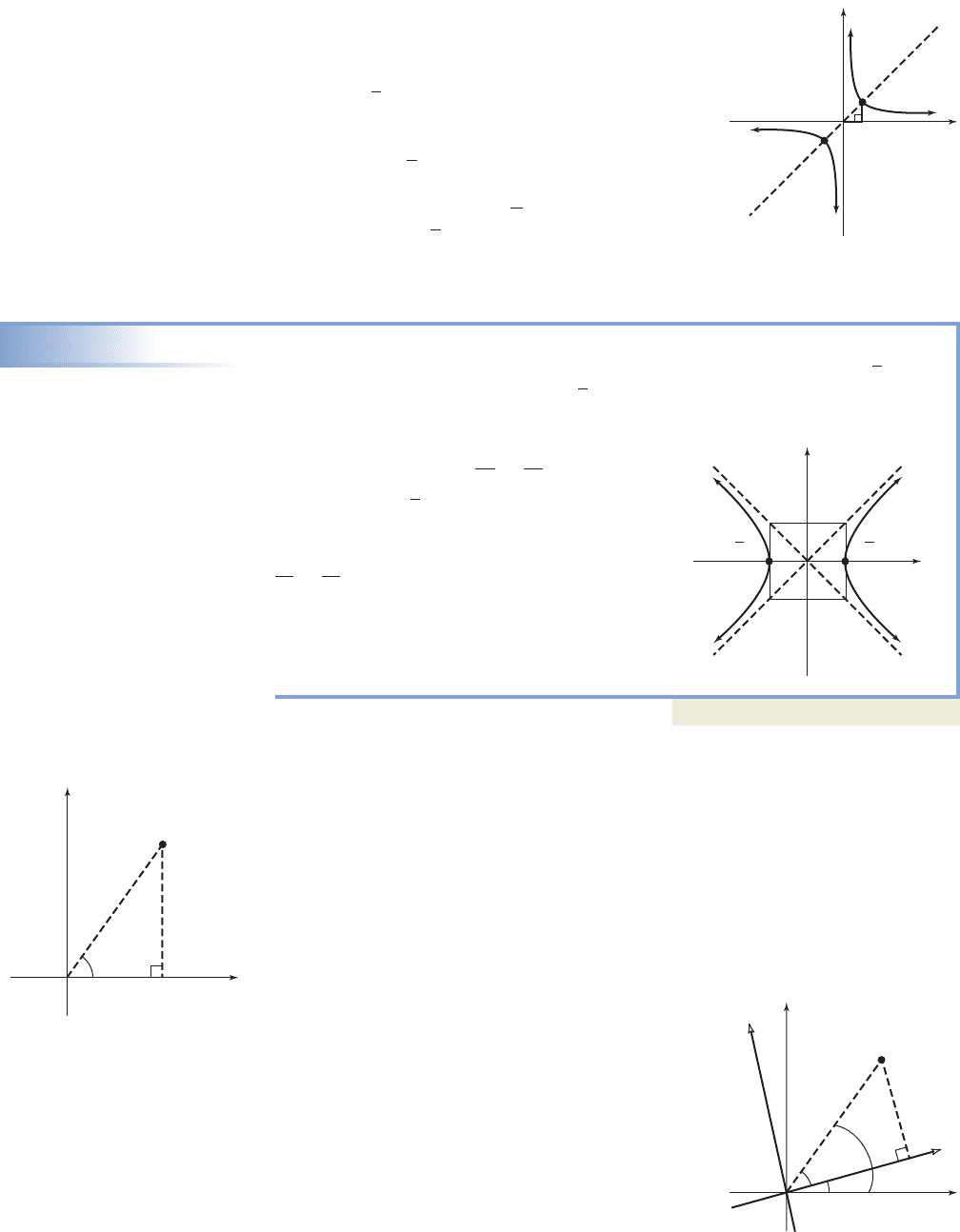
10-61 Section 10.6 More on the Conic Sections: Rotation of Axes and Polar Form 979
Note the polynomial form of this equation is
The resulting graph is shown in Figure 10.48,
and is actually the graph of a hyperbola with a trans-
verse axis of Using the 45-45-90 triangle indi-
cated, we find the distance from the origin to each
vertex is . If we rotated the hyperbola clock-
wise, we would obtain a more “standard” graph with
a horizontal transverse axis and vertices at
The asymptotes would be
and since is the general form
we know This information can be used to
find the equation of the rotated hyperbola.
EXAMPLE 1
Finding the Equation of a Rotated Conic from Its Graph
The hyperbola is rotated clockwise with new vertices at
asymptotes at and Find the equation and graph the
hyperbola.
Solution
Using the standard form and
substituting for a and b, the
equation of the rotated hyperbola is
or in polynomial
form. The resulting graph is the central
hyperbola shown.
Now try Exercises 7 and 8
It’s important to note the equation of the rotated hyperbola is devoid of the mixed
“xy” term. In nondegenerate cases, the equation
is the polynomial form of a conic with axes that are vertical/horizontal. However, the
most general form of the equation is and
includes this Bxy term. As noted in Example 1, the inclusion of this term will rotate
the graph through some angle Based on these observations, we reason that one
approach to graphing these conics is to find the angle of rotation with respect to the
xy-axes. We can then use to rewrite the equation so that it corresponds to a new set
of XY-axes, which are parallel to the axes of the conic. The mixed xy-term will be
absent from the new equation and we can graph the
conic on the new axes using the same ideas as before
(identifying a, b, foci, and so on). To find recall that
a point (x, y) in the xy-plane can be written
as in Figure 10.49.
The diagram in Figure 10.50 shows the axes of a new
XY-plane, rotated counterclockwise by angle In
this new plane, the coordinates of the point (x, y)
become and as
shown. Using the difference identities for sine and
cosine and substituting and
leads to
y r sin x r cos
Y r sin1 2X r cos1 2
.
x r cos , y r sin ,
,
.
Dx Ey F 0,Ax
2
Bxy Cy
2
Ax
2
Cy
2
Dx Ey F 0
x
2
y
2
2
x
2
2
y
2
2
1
12
x
2
a
2
y
2
b
2
1
b 12
.y 1x
112
, 02,45°,xy 1
b 12
.
y
b
a
xy 1x,
1a, 02S 112
, 02.
45°12
y x.
xy 1.
x
y
(1, 1)
1
1
(1, 1)
y x
x
y
(√2, 0) (√2, 0)
x
y
r
(x, y)
x r cos ␣
y r sin ␣
␣
x
y
r
(X, Y)
X r cos(␣ )
Y r sin(␣ )

␣ 
␣
X
Y
Figure 10.49
Figure 10.50
Figure 10.48
cob19529_ch10_0979-0994.qxd 12/6/08 12:49 AM Page 979 epg HD 049 :Desktop Folder:Satya 05/12/08:
